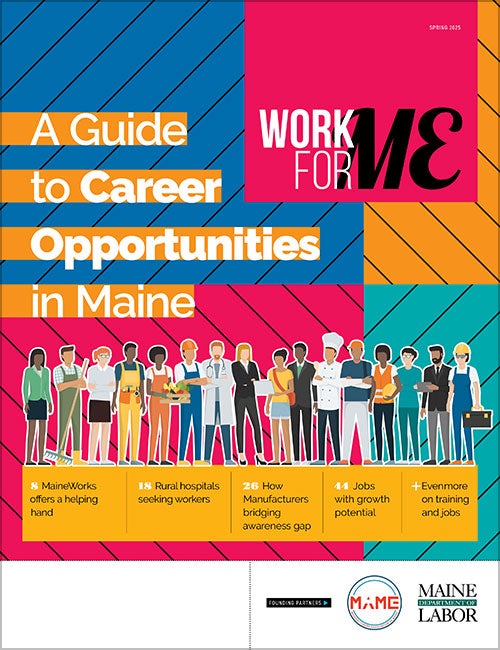Processing Your Payment
Please do not leave this page until complete. This can take a few moments.
- News
-
Editions
View Digital Editions
Biweekly Issues
- December 15, 2025
- December 1, 2025
- Nov. 17, 2025
- November 03, 2025
- October 20, 2025
- October 6, 2025
- + More
Special Editions
- Lists
- Viewpoints
-
Our Events
Event Info
Award Honorees
- Calendar
- Biz Marketplace
Bean encounter | Meet Peter Golbitz, whose Bar Harbor business provides information to the booming soy industry
"We were the subcontractors on a project to come up with ideas on how to grow and process soybeans in space on the Mars journey," says Peter Golbitz, the founder and president of Soyatech. The astronauts came to the right place. If anyone knows about these healthy little legumes ˆ and the fast-growing market for them ˆ it's Golbitz. The New York native has been studying soybeans and their potential since the 70s, when he moved to Bar Harbor after falling in love with Mount Desert Island on a camping trip.
Golbitz, 50, is the publisher of the Soya & Oilseed Bluebook, an annual publication that's considered the bible of the soy industry, and he and his staff of five do consulting work with institutions ranging from the U.S. Department of Agriculture to the World Bank, as well as with businesses and nonprofits from Brazil to Japan. He's chaired 10 international symposia on soyfoods, he speaks at multiple conferences a year, he won the 2004 Soyfoods Industry Leadership Award from the Soyfoods Association of North America and he travels the globe with a missionary zeal to promote soybeans. Needless to say, Golbitz is a busy man. And with the explosive growth of soyfoods ˆ the U.S. Department of Agriculture predicted in March that it expects soybean growers to plant a record 75.4 million acres this year ˆ he's likely to get even busier.
The soy business is big business these days. Once a New Age niche catering to hippies and the hyper-health conscious, soyfoods are becoming everyday staples thanks to the growth of soy milk and meat alternatives like Boca Burgers. As Americans have become more aware of cholesterol and the problems caused by being overweight, they've turned away ˆ at least in part ˆ from fatty animal products and toward foods like tofu and soymilk, which have been shown to reduce the risk of heart disease and help with weight loss.
The growth of the soy industry has been startling. In 25 years it has gone from $45 million in retail sales to $3.6 billion, according to the Soyfoods Association of North America. Since 1997 alone, sales have doubled. Over the past four years, the industry has released 6,000 new soy products, according to SANA. A survey from the United Soybean Board shows that one in six shoppers selects a soyfood today particularly because it contains soy. Soy has gotten so mainstream now that kids can get soy milk as part of their school lunches, thanks to legislation passed by Congress. Soy dogs are sold in ballparks, soy cheese is available at pizza parlors and Boca Burgers are on the menu at Denny's.
The question for Soyatech, though, is whether it can keep up with the international growth of the industry from its offices in the United States. Golbitz sees significant market potential in places like Argentina, Brazil and China, where the company's presence is not as strong as it is in the United States. To leap that hurdle, Golbitz plans to ally Soyatech with companies in other nations to share resources.
"We like building strategic partnerships with other companies to leverage their key assets to help us and have them do the same," he says. As an example he cites a recent agreement made with a Chinese enterprise, in which Soyatech will help them with contacts in this country, and they'll provide similar services for Soyatech in China, the world's largest importer of soybeans. "It's all about building personal relationships with individuals who know the country and the culture and the business," he says.
That's how it's worked for other Maine companies transitioning into the international market, according to Wade Merritt, director of the Bangor office of the Maine International Trade Center. "It's very much a relationship game," he says. "You have to network and get your name out there."
Beyond tofu
Born in New York, Golbitz visited Acadia National Park in the 70s, and says, "I couldn't believe people actually got to live here." He quickly moved north, and by 1980 he and his now-ex-wife had started a business making tofu. He supported himself initially by cooking in area restaurants and working as a program director at the local YMCA. But the couple's enterprise grew large enough that it was soon filling all of the tofu needs of the Hannaford chain. To survive, though, the company, then known as Island Tofu Works, would have had to grow still larger, and there wasn't really any place for it to do so.
"We were probably the largest tofu maker in Maine," says Golbitz. "But we were still only producing in one week what others in Boston and places like that were producing in a day. There were already two other large businesses in Boston, so there was no place to expand our market to the south, and we didn't want to try to expand north."
Instead, "We ended up doing some consulting work related to soyfoods for Dannon, Hood, Ocean Spray and others," he says. "We were developing products for them, and we accompanied that with market research." This seemed to make more sense than building a big soy factory and trying to compete in the Boston market and, in 1984, Soyatech was born.
The year after its founding, Soyatech began to publish a newsletter about soyfoods, thanks to the nascent miracle of desktop publishing. The newsletter attracted the interest of the American Soybean Association, which represents 400,000 soybean farmers across the country. The ASA had been publishing the industry bible ˆ the Soya Bluebook ˆ since 1947, but it wanted to offload the title and asked whether Soyatech was interested in taking it over. Golbitz was. It was a smart move because "the book," as Golbitz calls it, has become Soyatech's biggest moneymaker.
Soyatech did its first edition in 1988. Golbitz and company expanded the title and gradually integrated other seed oils, like canola, palm and peanut. They renamed the book the Soya and Oilseed Bluebook in 1999, stuffed it with comprehensive information ˆ lists of growers and processors, industry statistics and trends ˆ and watched it grow as the industry has taken off. "We were just selling more and more advertising," says Golbitz. The $99 title is now 400 pages, and it accounts for about 60% of Soyatech's annual revenues of $500,000. "Of that, probably two-thirds is advertising sales, and the other third is from subscriptions," says the publisher.
The company distributes about 2,000 books a year to subscribers including processing plants, multinational firms such as Archer Daniels Midland and Cargill, equipment and service companies, government agencies, commodities brokers and libraries.
Soyatech complements the information within the book with stories and studies it publishes on its subscriber-based website, www.soyatech.com. In 2002, the firm launched a daily news feed, which is e-mailed to 3,500 subscribers.
The other 40% of the company's income comes from its consulting and market research. "We've consulted with many large multinational food companies and we have ongoing projects in Japan, Brazil, with a biotech firm, with food manufacturers, with a Japanese trading company, and with SPINS in San Francisco, which does soy market update studies," says Golbitz. In this capacity, Soyatech prepares multi-client reports, proprietary reports and product studies, most of which "revolve around edible soy products," as opposed to livestock feed or processing, according to Golbitz. The company has a couple of subscribers in Maine and has done talks for the Maine Department of Agriculture, but otherwise does most of its business outside the state. (See "Against the grain," p. 25.)
The trend for tofurkey
A couple of big breakthroughs led to mass acceptance of soy products, Golbitz says. The first was the 1996 arrival of soy milk in the dairy case. "They reformulated it to taste better," he explains, "and then took it off the grocery shelf, where it was tucked away in some corner, and put it in the dairy case right next to milk." The product took off. Then in the late 90s, meat alternatives ˆ veggie burgers, etc. ˆ started to make names for themselves as more and more people began to worry about their cholesterol levels.
Once soyfoods proved they could sell, all of the big food conglomerates in the nation wanted in on the action, which has helped with advertising and product placement, causing growth to skyrocket. "ConAgra bought Light Life Foods, and Dean Foods bought White Wave," says Golbitz with a wry tone. "So now you have one of the largest meat packers in the world owning the largest veggie burger company and the largest dairy owns the largest soy milk producer." Coca Cola now markets soy milk under the Odwalla brand (which in turn purchased local juice maker Fresh Samantha); Kraft bought Boca Foods and Kelloggs bought Boca rival Morningstar Farms.
For all these giants to really make a dent in the American marketplace, Golbitz thinks the industry needs another big breakthrough product. "I see two real possibilities," he says. "The first is cultured soy products. The same demographic that buys yogurt today is also your soy consumer ˆ largely women, concerned about calcium, nutrition, protein, and with higher disposable income." Soy yogurts take in about $50 million a year now, according to Golbitz. "I could see it doing $500 million fairly quickly."
The other area is in fresh, refrigerated meat alternatives sold right next to the meat. "These would be whole cuts of meat like steak or chicken breasts," says Golbitz. "We have the technology now to make it look just like the real thing and to function and grill the same way. As for taste, it will probably be flavored or marinated and ready to cook." None of the meat alternative manufacturers have distribution in the meat case ˆ yet. "It'll take a company with guts and deep pockets to muscle into the meat section."
Supermarket shoppers aren't the only ones noshing on soybeans. In fact, the majority of the beans grown are for livestock feed. "Eighty-five percent of the world's soybeans are fed to animals," says Golbitz. "Only about 10% are sold to humans and, of that, 90% are sold to Asia."
Soy bomb
Though the rise of Soyatech has paralleled the rise of the soyfoods industry, it isn't inextricably tied to it. For example, some controversial studies have suggested that soy is not as healthy as once thought. Shortly after the Food and Drug Administration announced in 1999 that it would allow soyfoods to claim cholesterol benefits on its packaging, several studies appeared linking soy consumption to everything from pancreatic cancer to Alzheimer's. Golbitz doesn't give the studies much credence. "Most of the publicity is based on clinical studies on very isolated compounds in very high doses," he says. "Nobody eats large quantities of those extracted compounds. You could extract compounds from any plant and overdose someone on them. The vast majority of studies have shown that soy is extremely healthy. Just look at Asia, where soy is a staple in the diet."
In fact, such controversies tend to help Soyatech's business. "Whenever there are studies like that it only helps us," he says. "When there are fluctuations in the market, people want to know what's going on."
Some might turn to the Web for this information, which concerns Golbitz a bit (although he says the firm has no real direct competitors). "So much is given out for free on the Net," he says. "We have to continue to make sure we have value-added information. Although you can do a soybean search on Google and find a lot of results, you won't find a comprehensive list of manufacturers, for example."
Nancy Chapman, executive director of the Washington, D.C.-based Soyfoods Association of North America, thinks providing value-added information is what Soyatech does best. "In this particular area of expertise, there isn't another company like it. It's unique in its role. Soyatech has a very perceptive way of interpreting sales data, as well as collecting it," she says. "There are others who collect soy sales data but Peter Golbitz does an extraordinarily valuable service interpreting it." As for the Soya Bluebook, Chapman says "it links farms all the way to the retail level and it provides a tremendous international level of service no one can duplicate."
It's the international market, though, that concerns Golbitz. Soyatech has grown 50% in the last five years, both in revenues and employees. And Golbitz has ambitious plans for the company: "I'd like to double in size in the next few years," he says, "and I think that's possible."
But the company doesn't have the resources to open offices in booming soy centers overseas, which is why Golbitz has been actively partnering with publishers and likeminded businesses in foreign markets. In addition, he's working on a project to bring soy to developing countries. (See "On a mission," p. 24.)
In the end, his business is as much about missionary zeal as it is about profit. "We can't survive as a meat-centered society if we want to have enough resources for everybody," he says. "We don't have infinite amounts of land and water."
Soyatech
President: Peter Golbitz
Founded: 1984
Employees: Six
Product: Publishing, consulting and market research for the soyfoods industry
Revenues, 2004: $500,000
Contact: 288-4969
www.soyatech.com
On a mission
As part of its humanitarian mission, the company last fall partnered with the St. Louis-based World Initiative for Soy in Human Health with the goal of raising $300,000 from industry sources to fund a soybean pilot project at the Food Research Institute in Pretoria, South Africa. If successful, the program will likely get a matching grant from the U.S. Agency for International Development. "We're relatively confident we'll have our match," says Jim Hershey, executive director of WISHH.
The project would teach companies from eight countries in southern Africa to process soy milk and textured soy flour ˆ "to get more protein into the diet of Africans," says Golbitz. "Africa is a disaster now, between AIDS and malnutrition. The lack of protein has created a dependent culture. We want to show them how to process soy themselves and not be so dependent" on outside help.
Soy makes more sense than other forms of protein, according to Golbitz. "There are enough soybeans grown today to give every man, woman and child 30 kilograms each ˆ enough to meet half of their protein needs for a year," he says. "What happens, though, is that we as a meat-consuming nation gobble up all that valuable protein. We feed it to livestock ˆ it takes 15 pounds of soy meal to feed an animal and make one pound of meat ˆ and we're not making it available to developing countries."
If the project in Pretoria is a success, Golbitz and WISHH plan on expanding to Central America next. "This is a two-year project that would start this fall," he says. "Once we get this one rolling we are going to try to place one in Mexico City or some other location with quick access to Central America."
So far, things look good, according to Golbitz. "I just got back from a [fundraising] trip and the response [from soyfood companies] was phenomenal. It looks as if we have raised the money we need or are pretty close," he says. "One thing about the soy industry, as someone once said, it's full of 'right livelihood' kinds of people who want to change the world one bean at a time."
Which is a pretty good description of Peter Golbitz and Soyatech. "We want to be part of a force for change," he says. "We want to provide as much info to as many people as we can."
Against the grain
"We were up around 2,000 acres then, growing for food," says Vern Delong, executive director of the Presque Isle-based Agricultural Bargaining Council, of the crop in Aroostook County. Today the number of acres in Maine's largest agricultural area is substantially less, and the beans are largely grown to be used as livestock fodder. "We're probably at about 350 acres," says Delong. "There are probably more soybeans being grown in southern Maine than in the County. A few farmers down there are growing beans for livestock feed. It's hard to compete in that market with short-season beans" ˆ the only ones that will grow in the County. Many farmers who were planting soy have switched to more profitable canola, which now accounts for about 4,000 acres, according to Delong.
Quite aside from making more fiscal sense than soybeans ˆ it grows quicker and easier in Maine for larger yields ˆ canola also gets along better with potatoes. "Soybeans weren't perceived as beneficial as a rotational crop with potatoes," says Matt Williams, an educator with the University of Maine Cooperative Extension in Houlton. "Canola was. That's because of certain disease prevention potential, and other nutrients that it brings to the soil."
Mainebiz web partners

The Giving Guide
The Giving Guide helps nonprofits have the opportunity to showcase and differentiate their organizations so that businesses better understand how they can contribute to a nonprofit’s mission and work.
Learn More
Work for ME
Work for ME is a workforce development tool to help Maine’s employers target Maine’s emerging workforce. Work for ME highlights each industry, its impact on Maine’s economy, the jobs available to entry-level workers, the training and education needed to get a career started.
Learn More
Groundbreaking Maine
Whether you’re a developer, financer, architect, or industry enthusiast, Groundbreaking Maine is crafted to be your go-to source for valuable insights in Maine’s real estate and construction community.
Learn more-
The Giving Guide
The Giving Guide helps nonprofits have the opportunity to showcase and differentiate their organizations so that businesses better understand how they can contribute to a nonprofit’s mission and work.
-
Work for ME
Work for ME is a workforce development tool to help Maine’s employers target Maine’s emerging workforce. Work for ME highlights each industry, its impact on Maine’s economy, the jobs available to entry-level workers, the training and education needed to get a career started.
-
Groundbreaking Maine
Whether you’re a developer, financer, architect, or industry enthusiast, Groundbreaking Maine is crafted to be your go-to source for valuable insights in Maine’s real estate and construction community.
ABOUT
NEW ENGLAND BUSINESS MEDIA SITES
No articles left
Get access now
In order to use this feature, we need some information from you. You can also login or register for a free account.
By clicking submit you are agreeing to our cookie usage and Privacy Policy
Already have an account? Login
Already have an account? Login
Want to create an account? Register
Get access now
In order to use this feature, we need some information from you. You can also login or register for a free account.
By clicking submit you are agreeing to our cookie usage and Privacy Policy
Already have an account? Login
Already have an account? Login
Want to create an account? Register







Comments